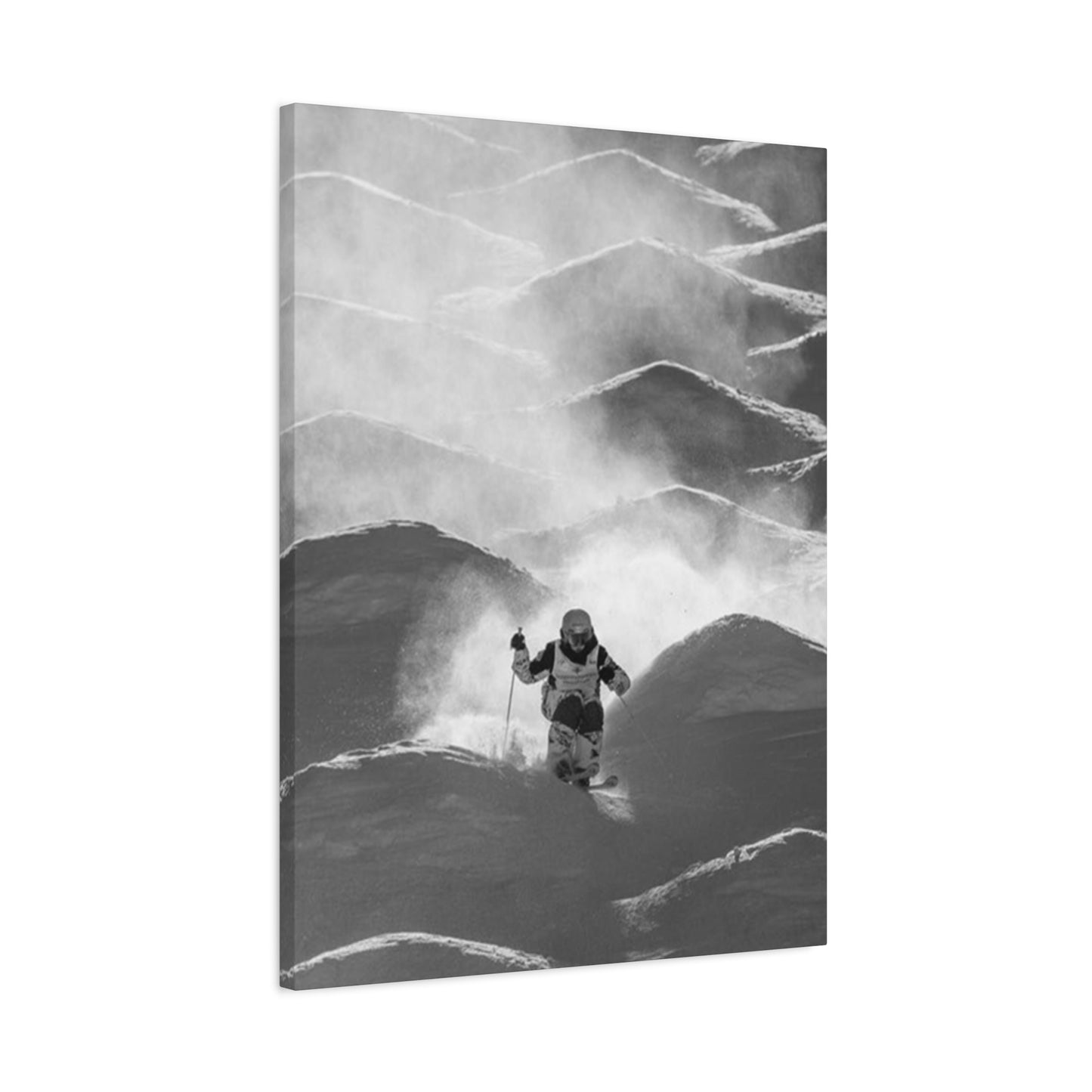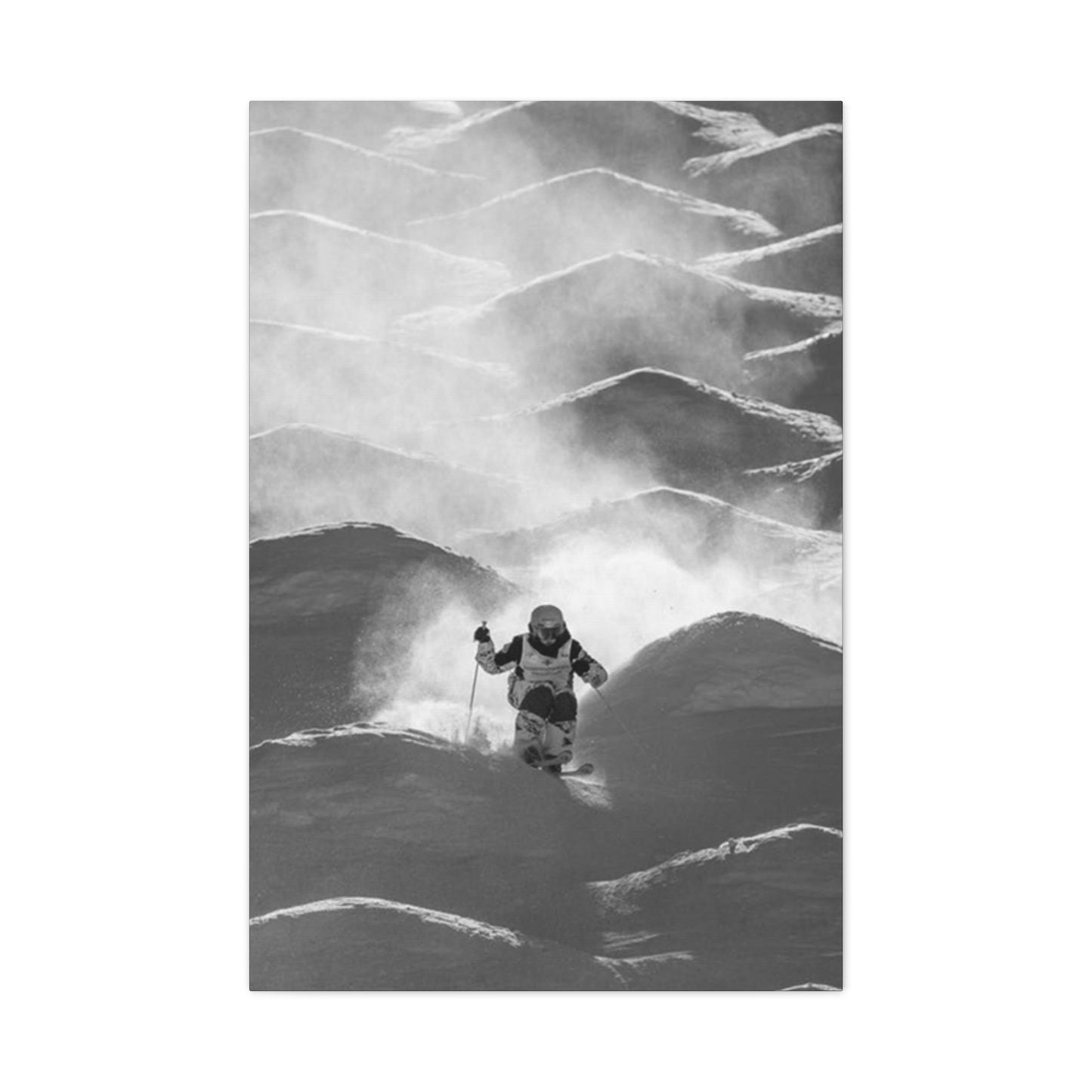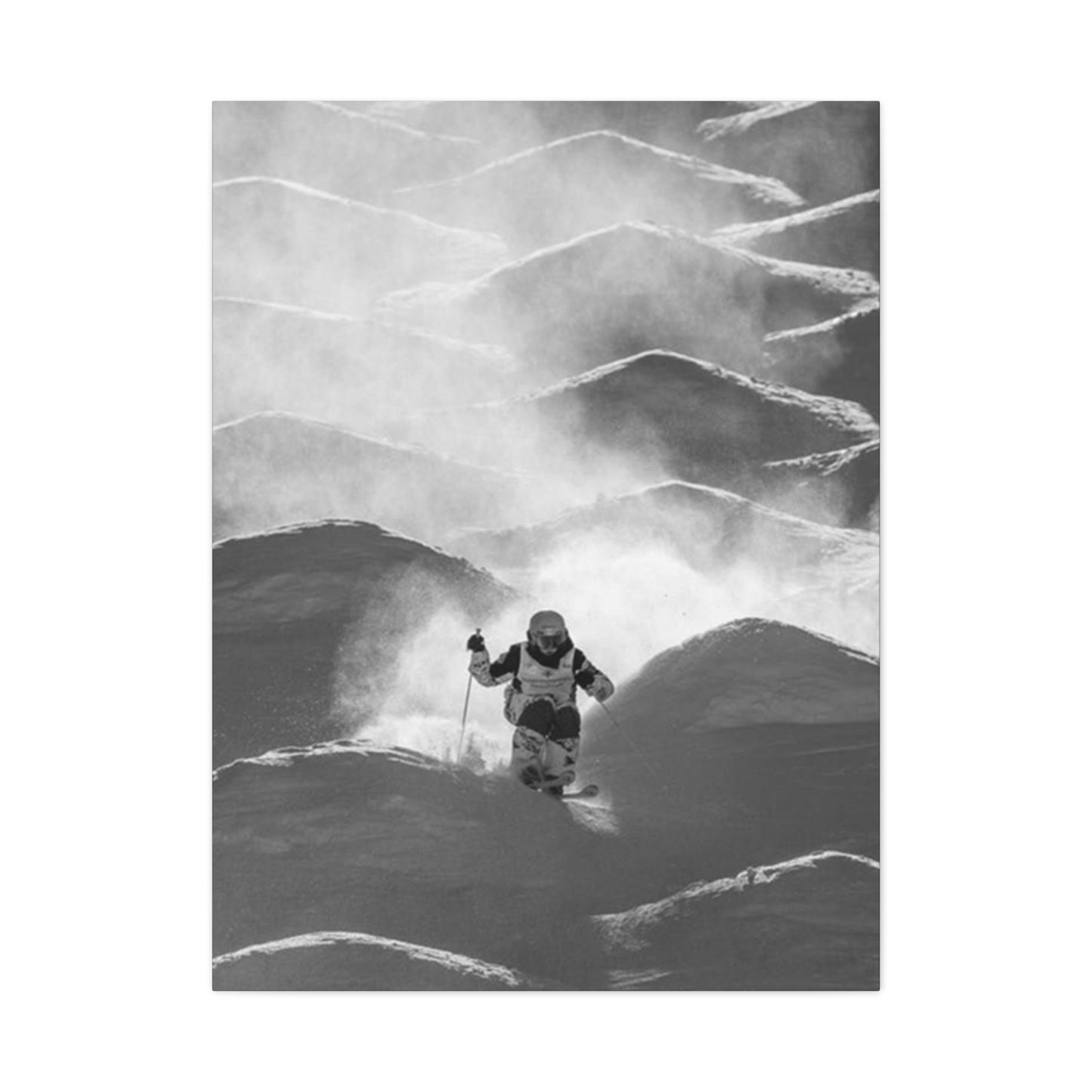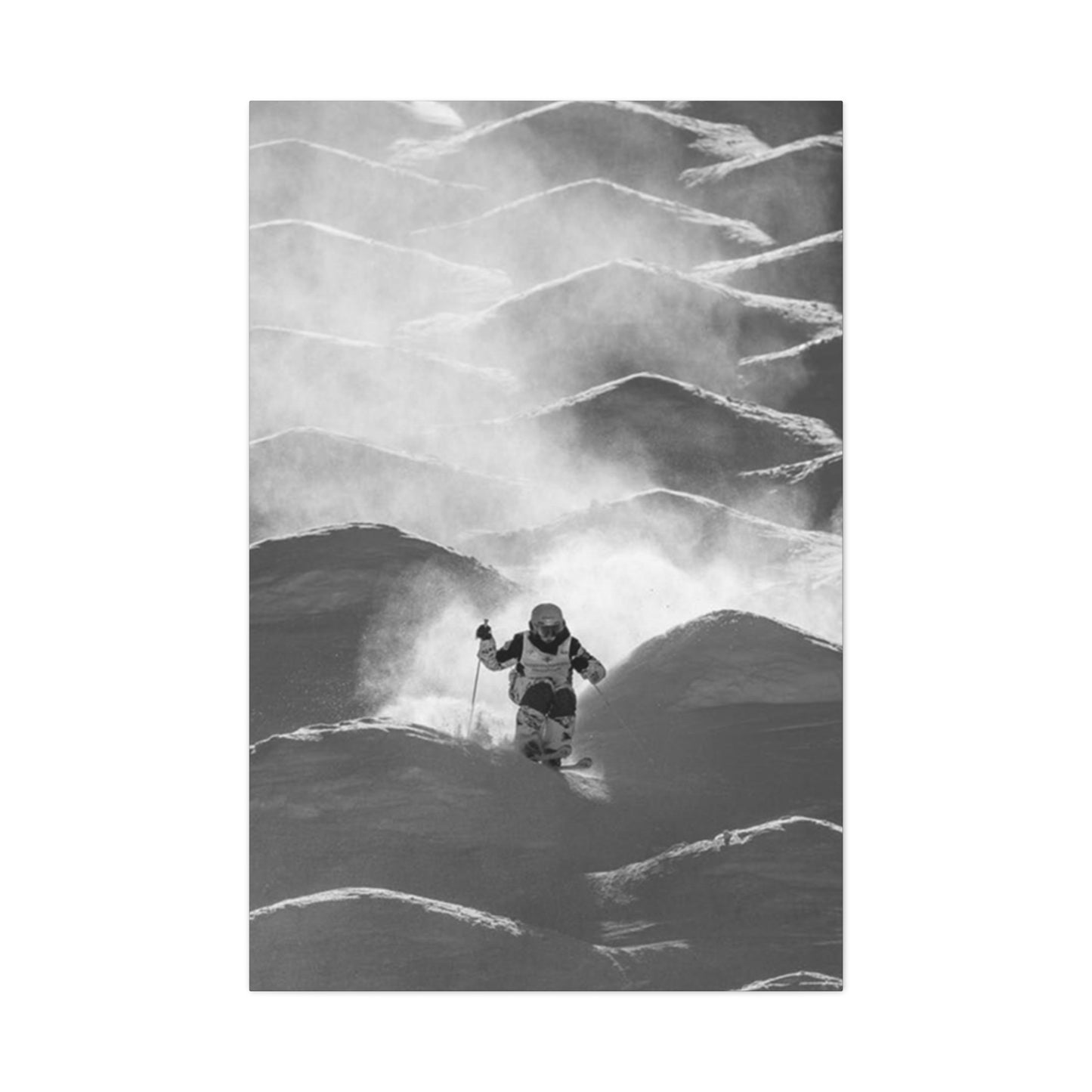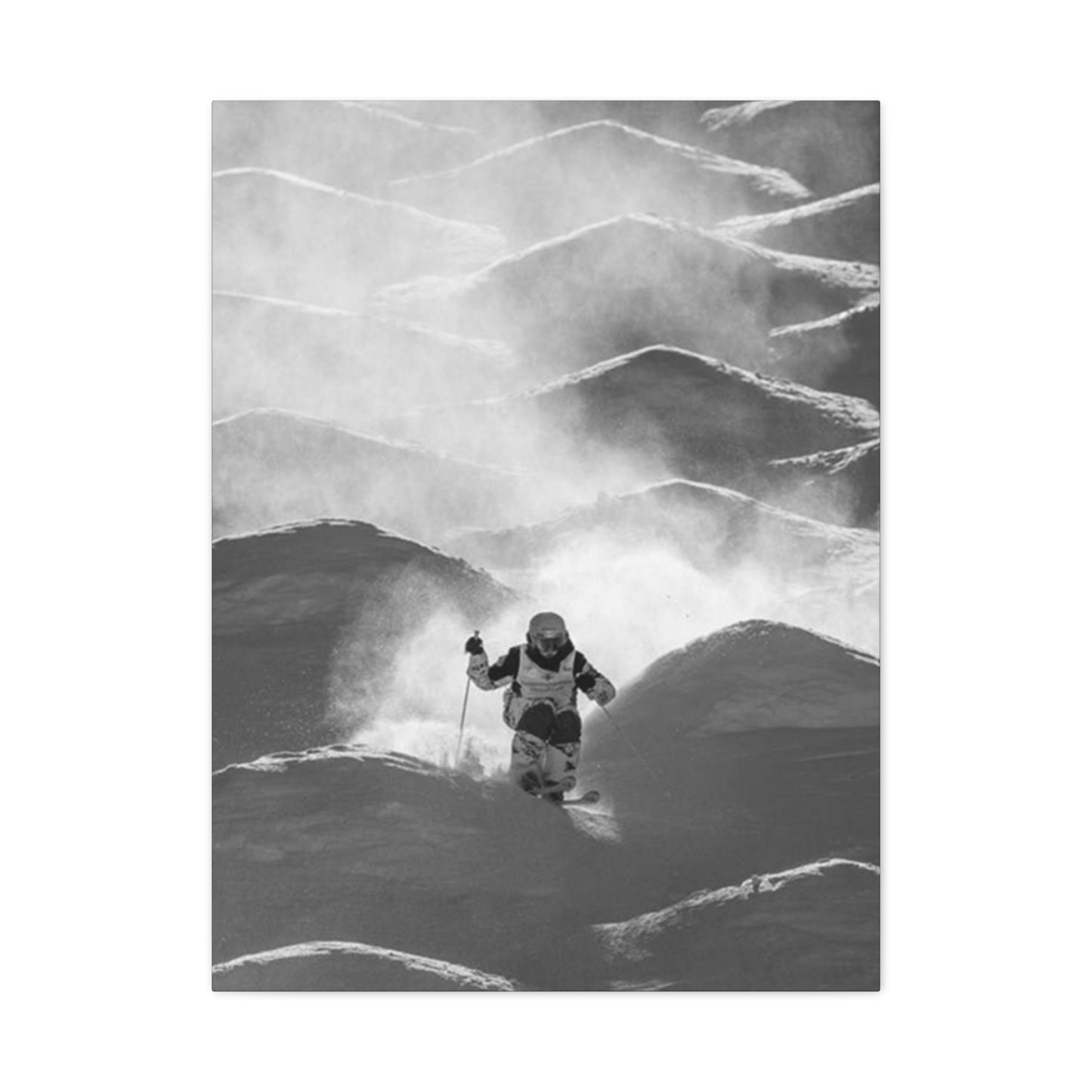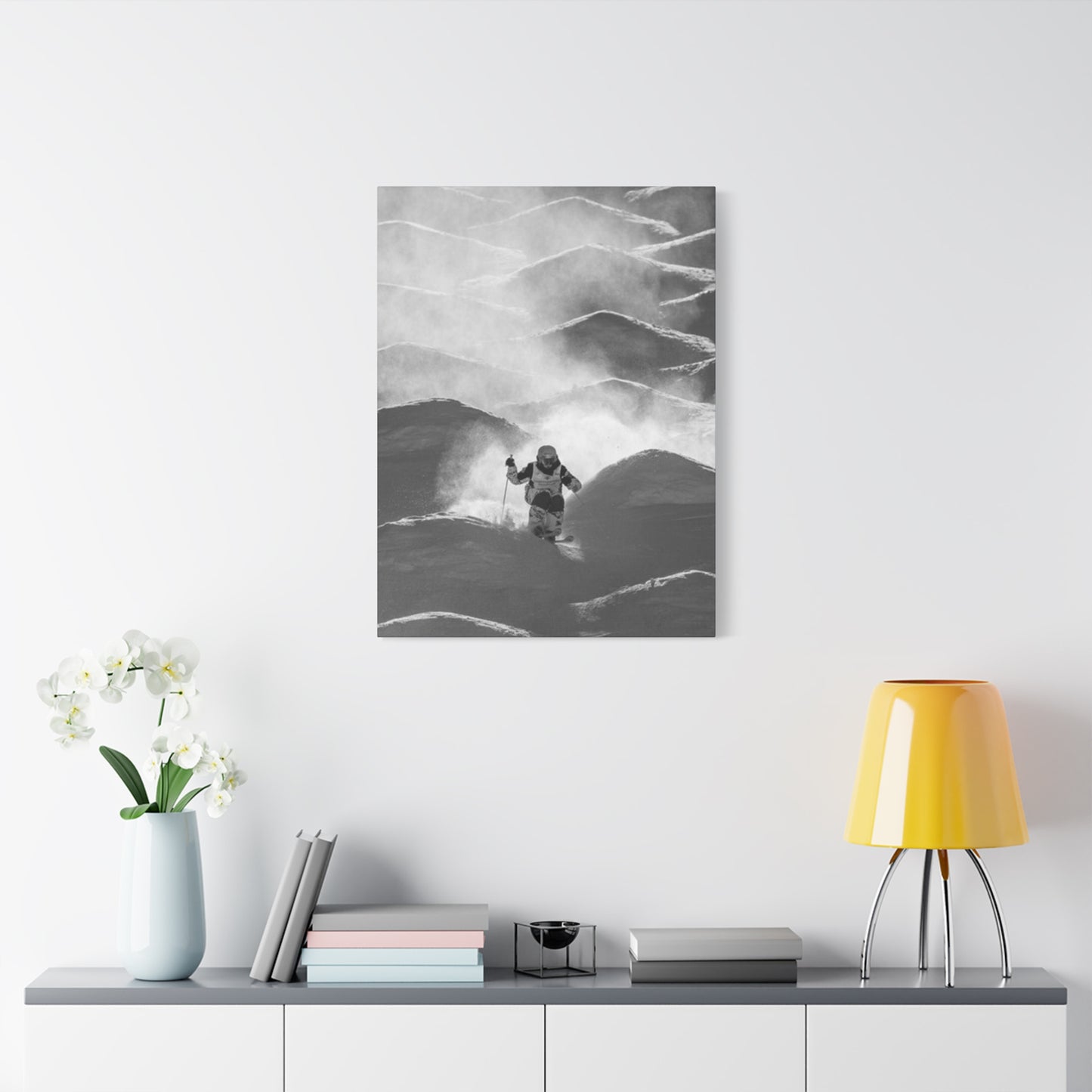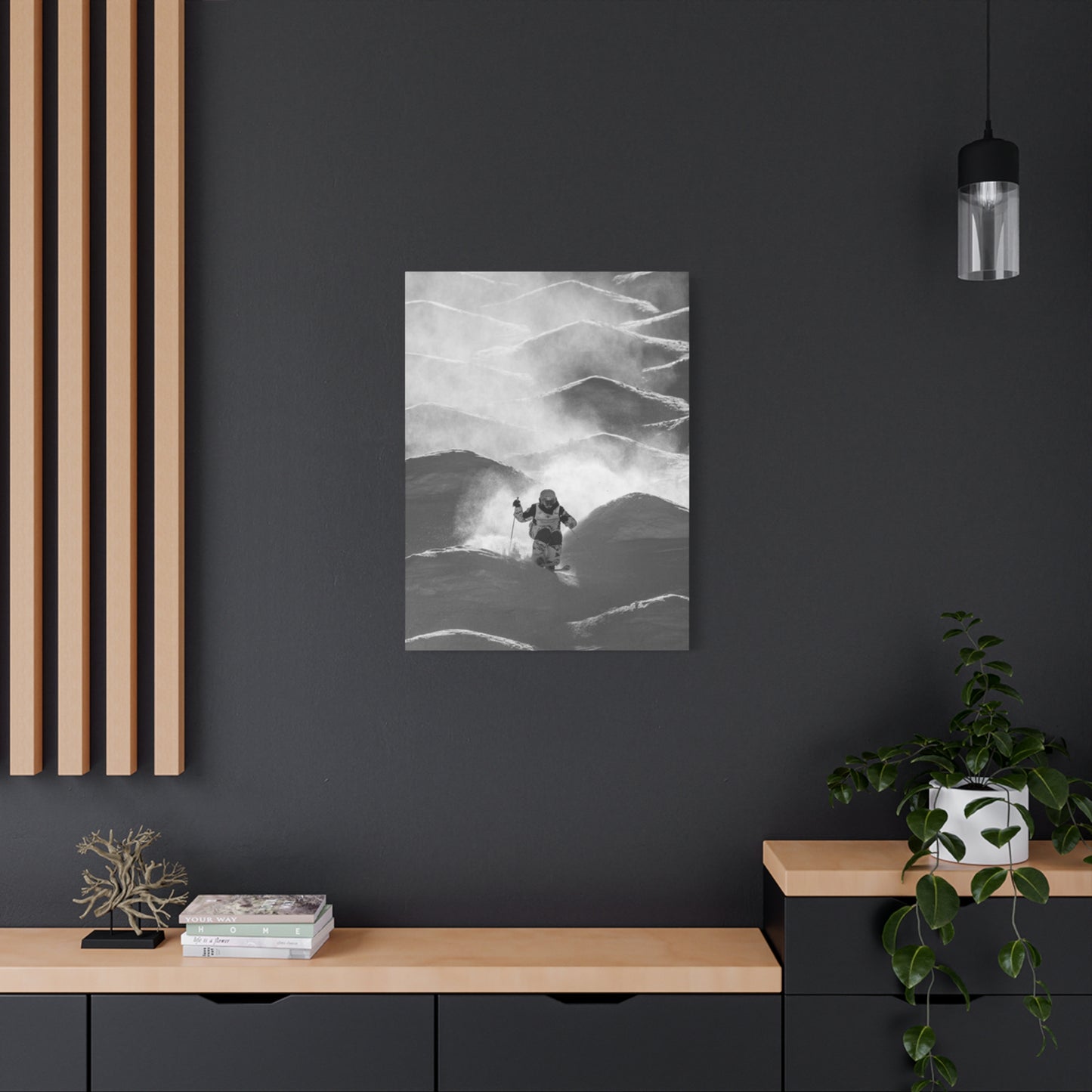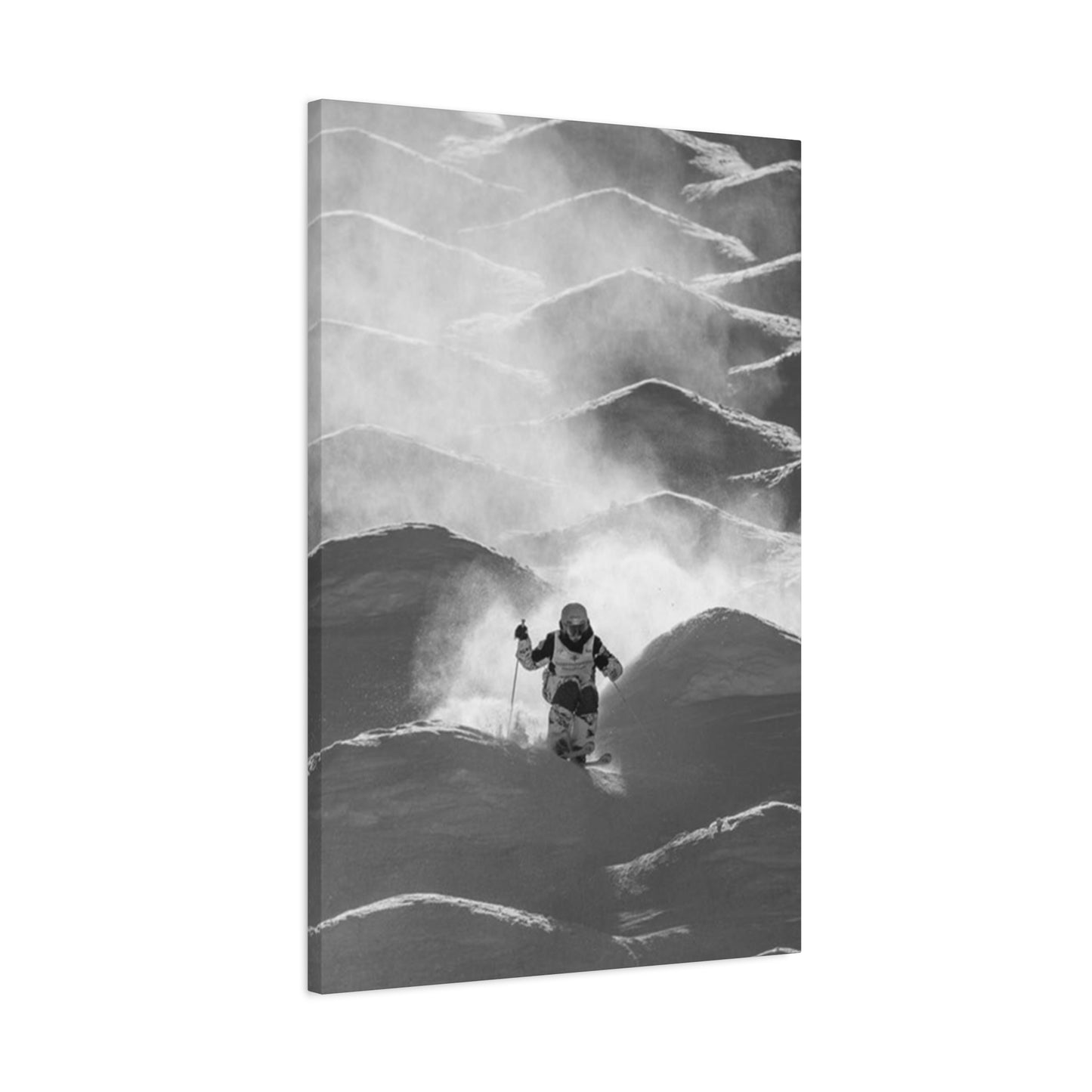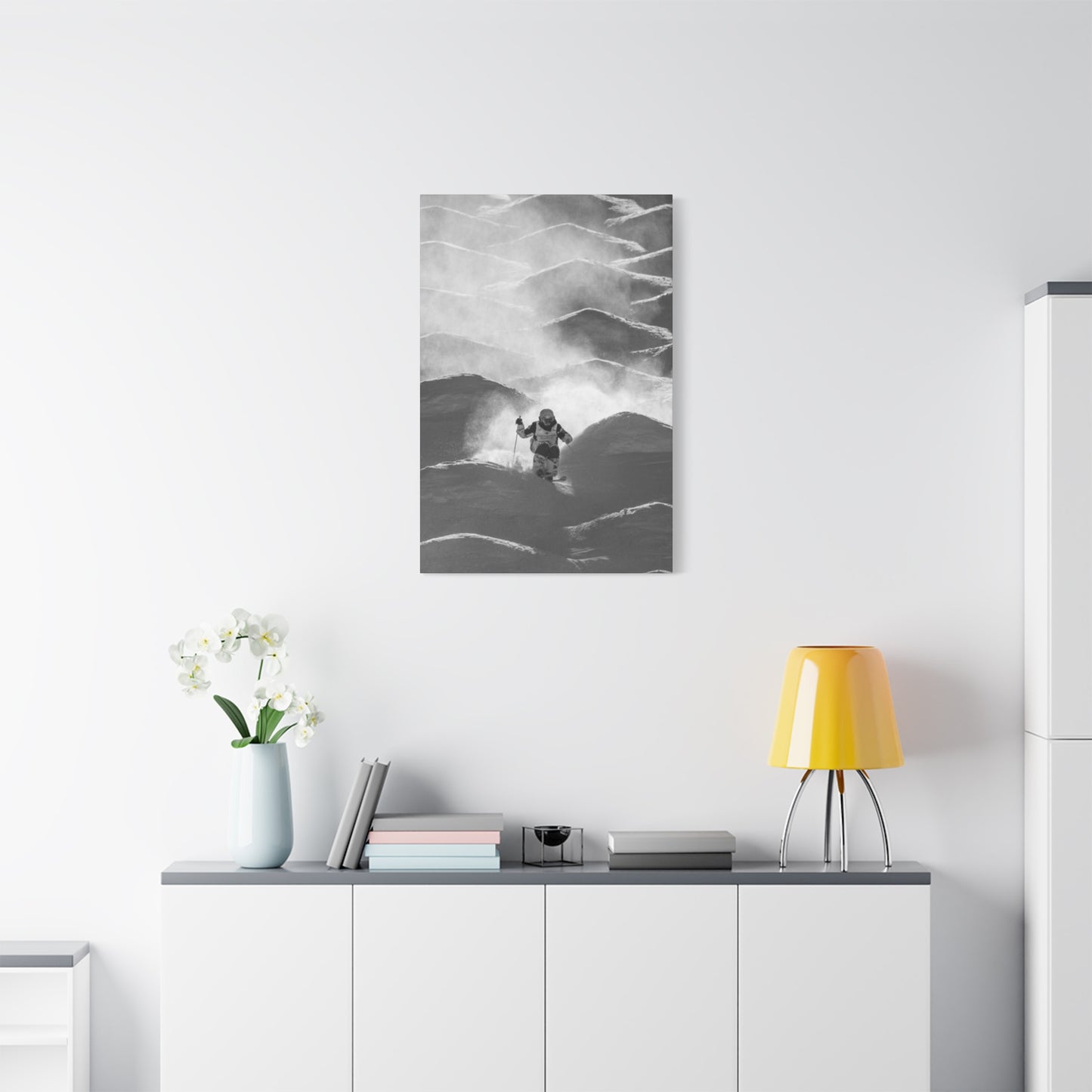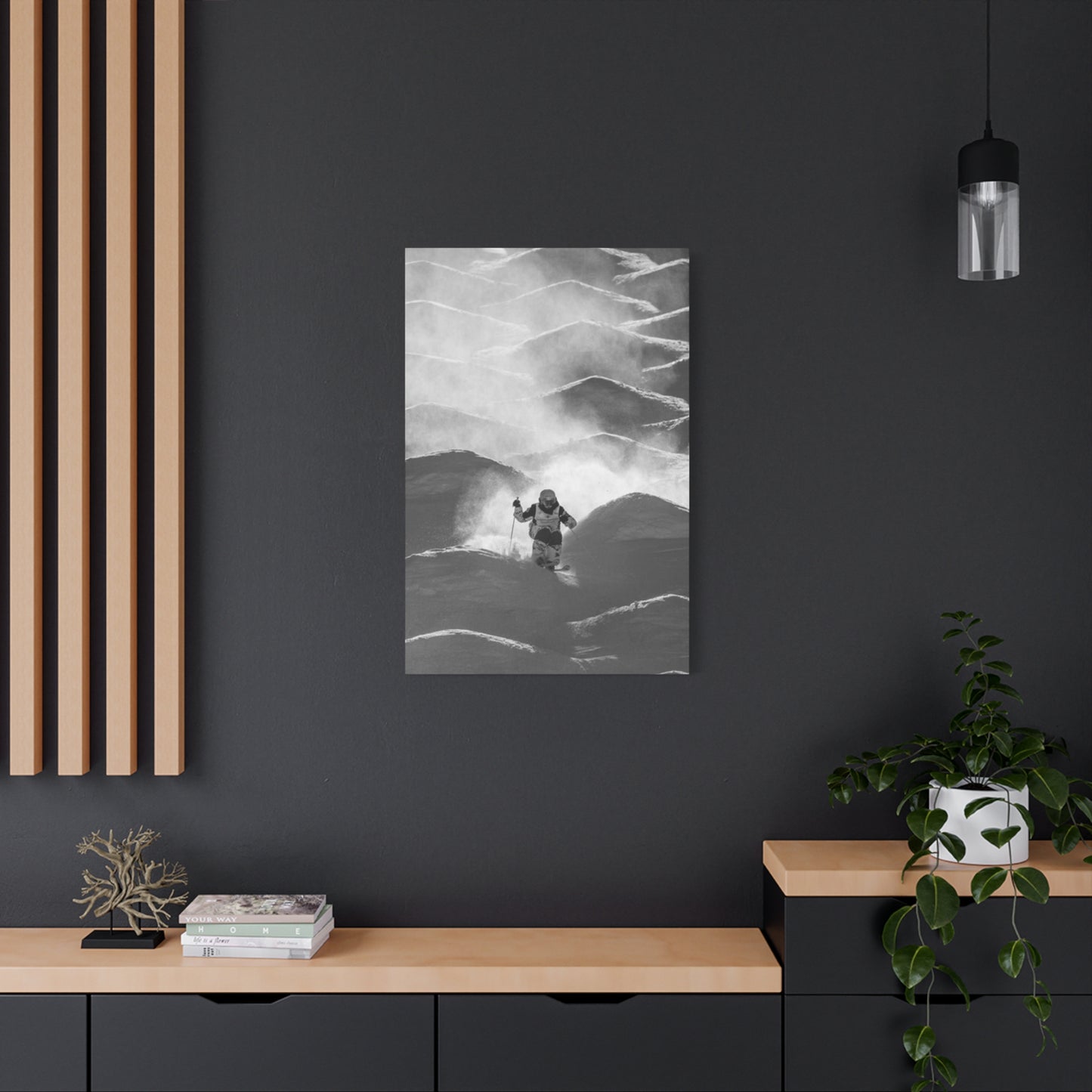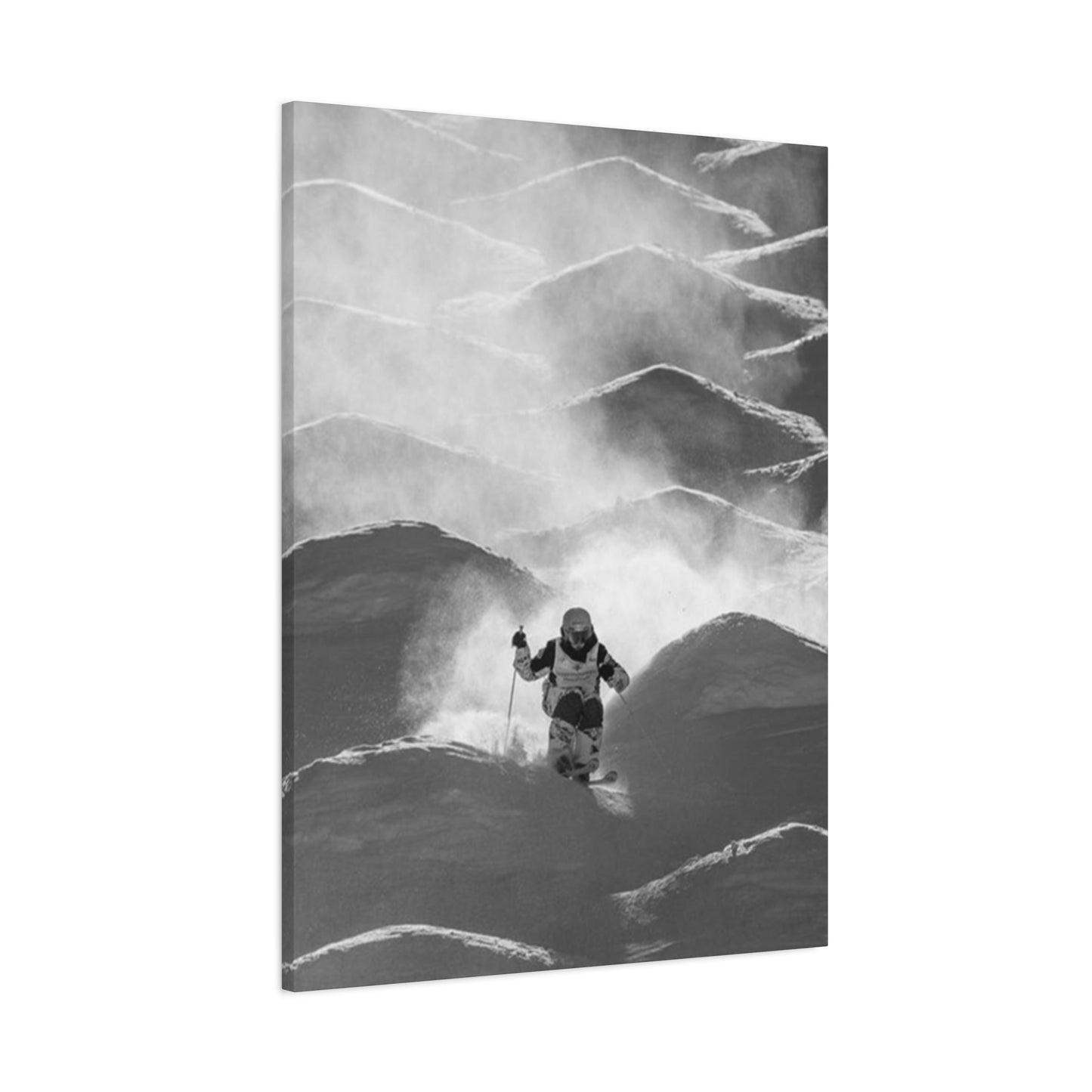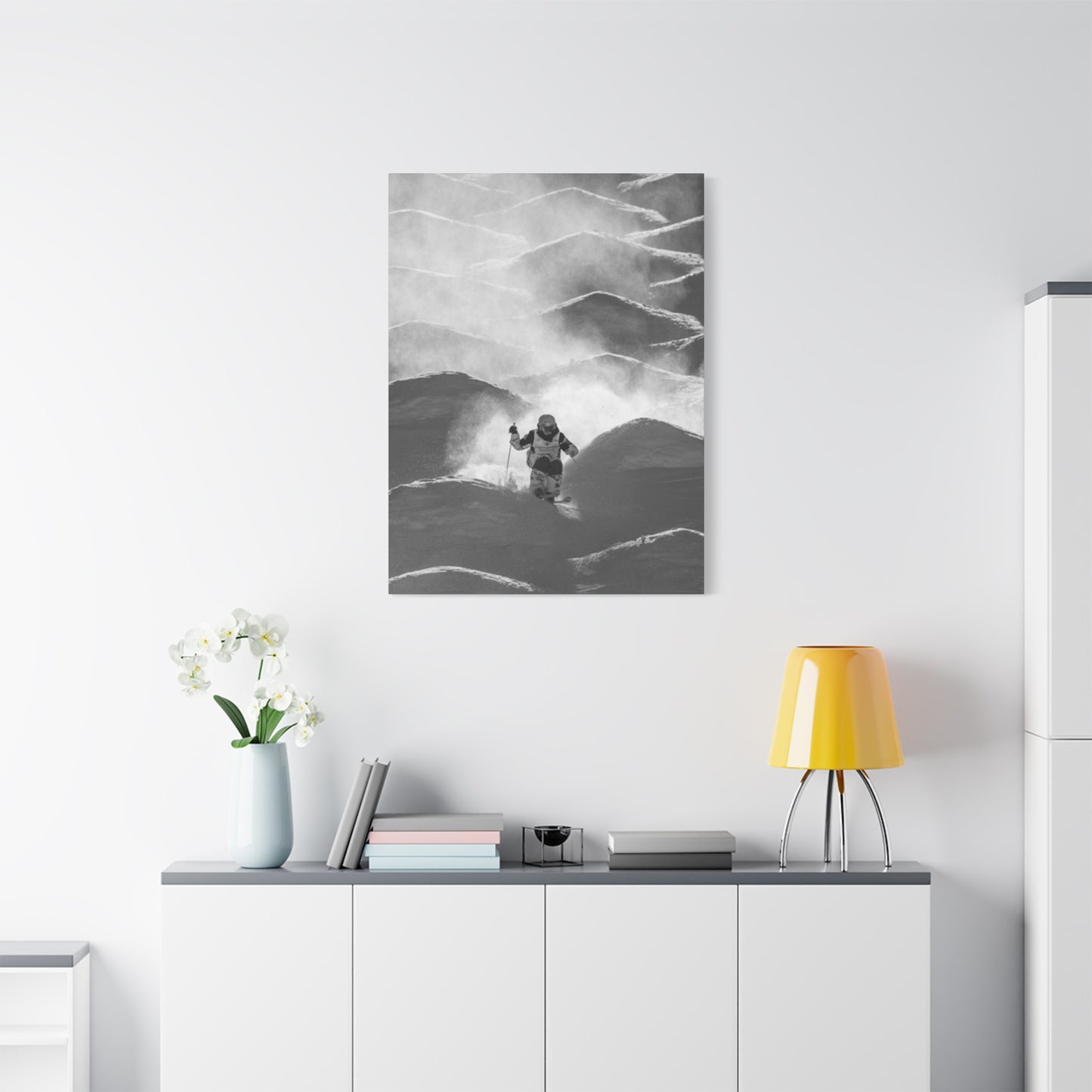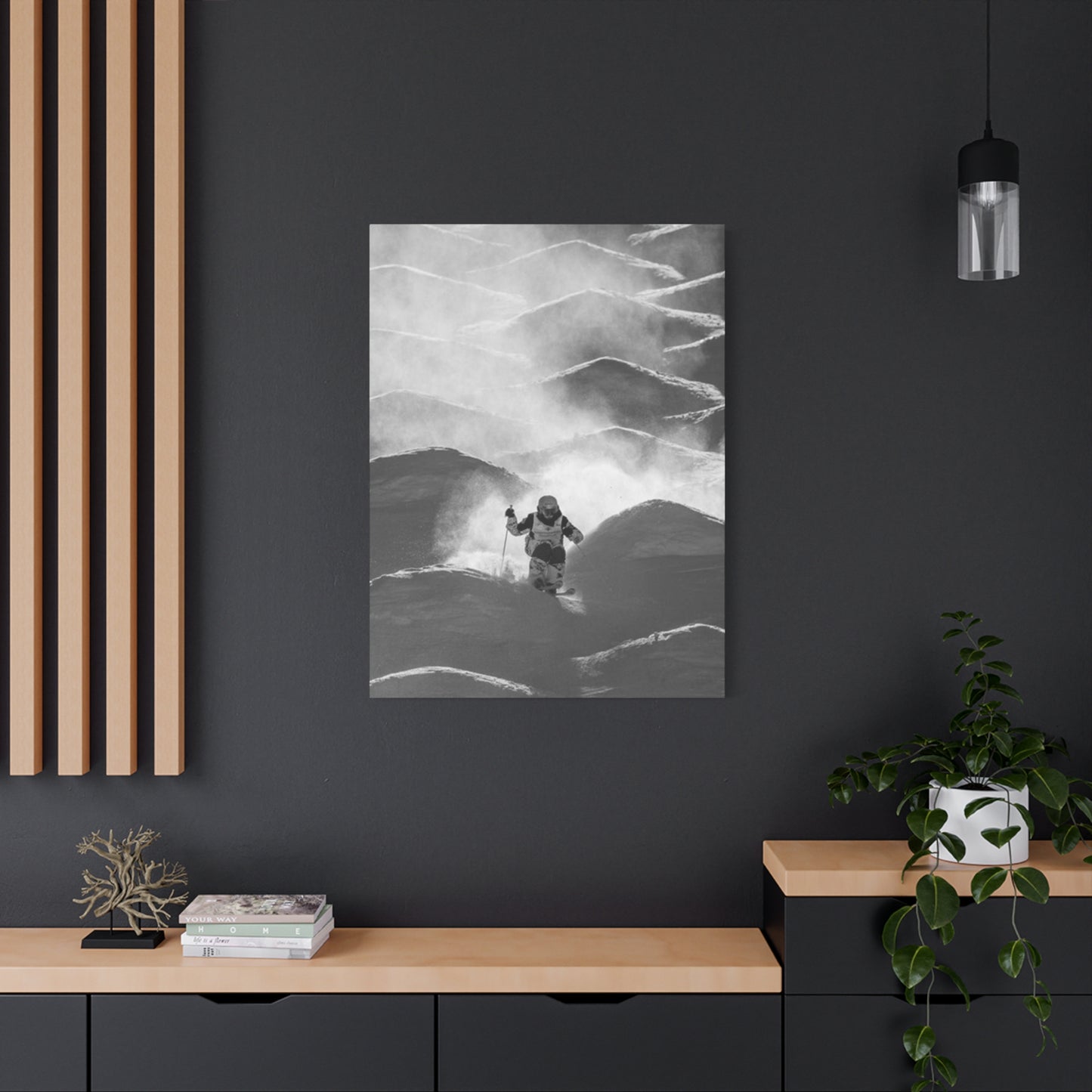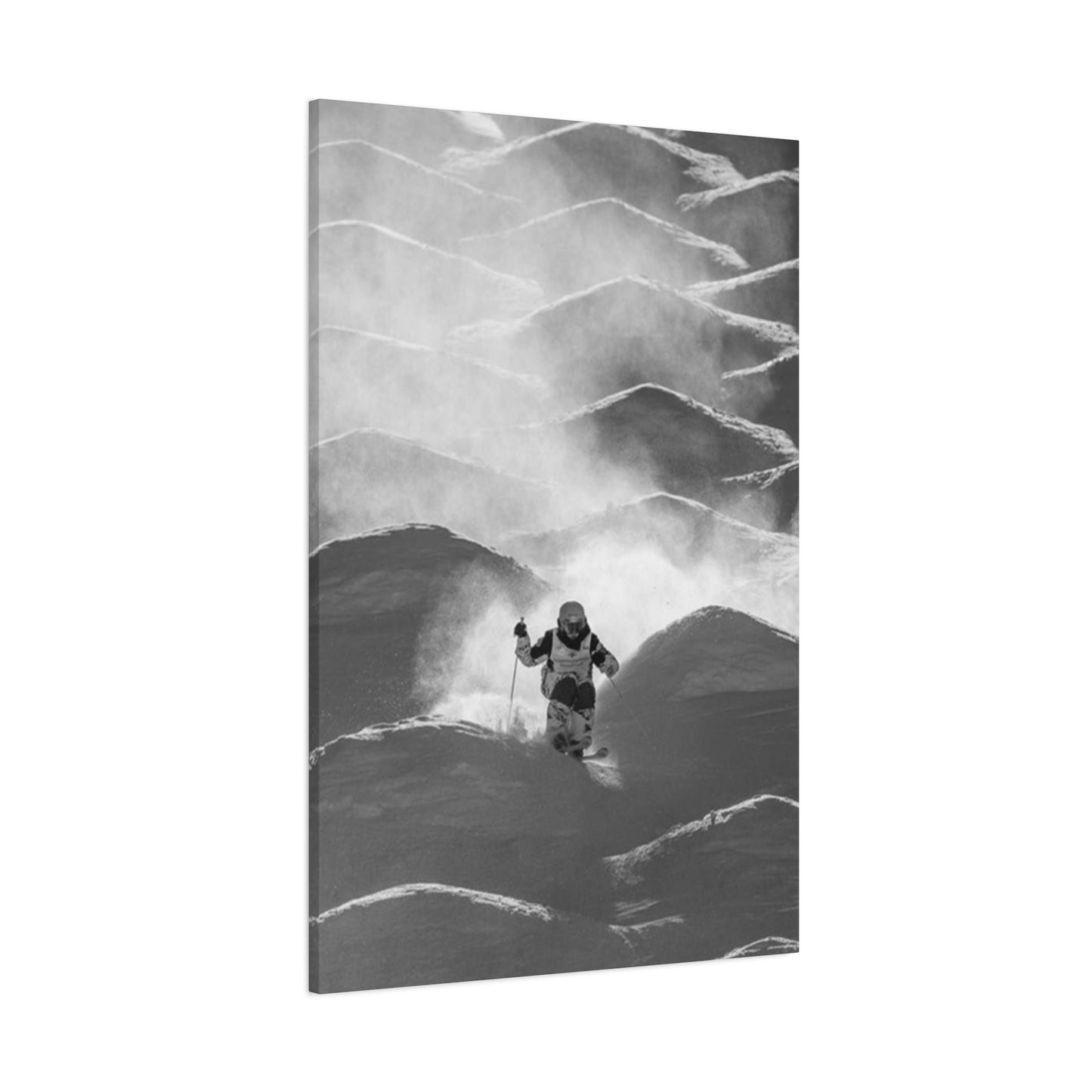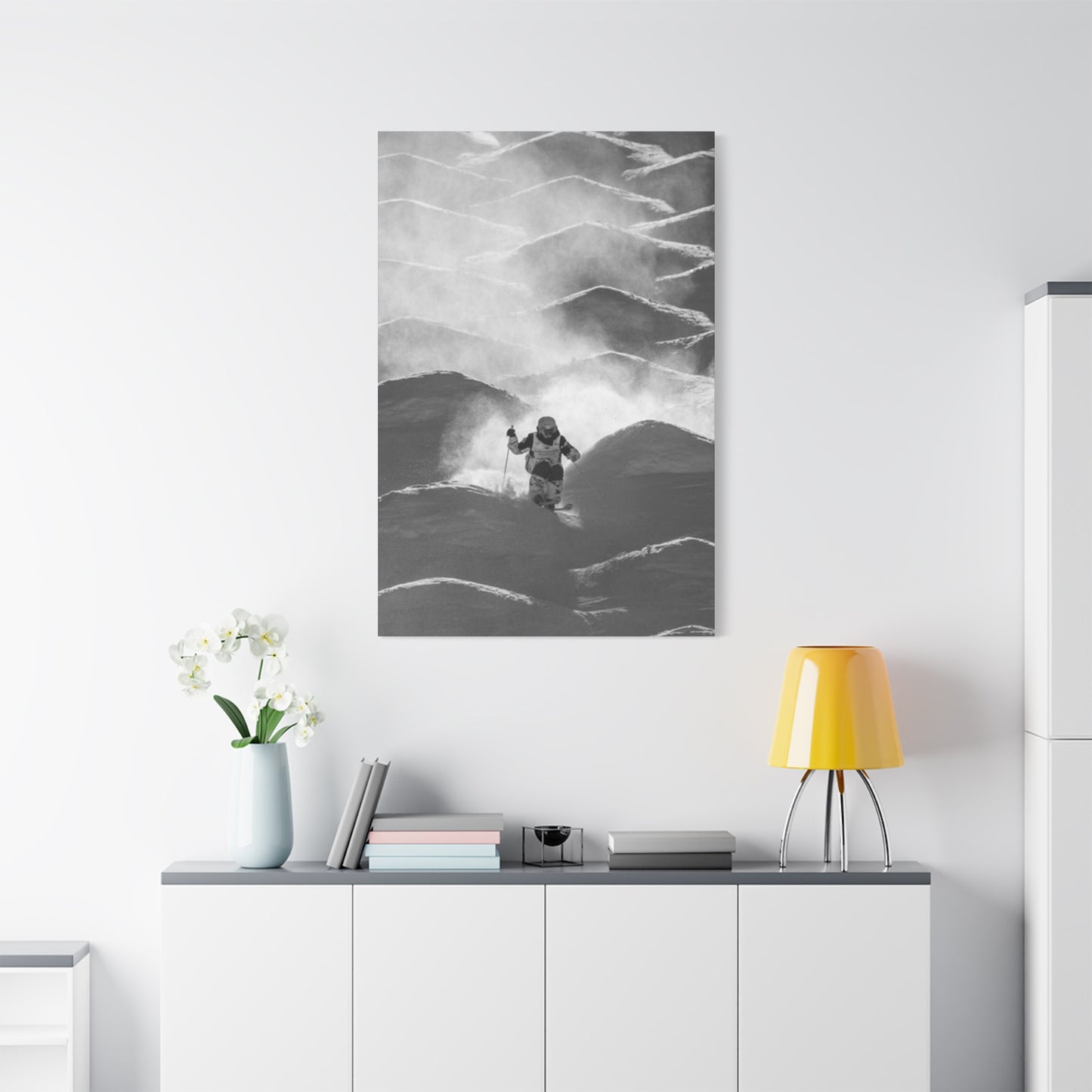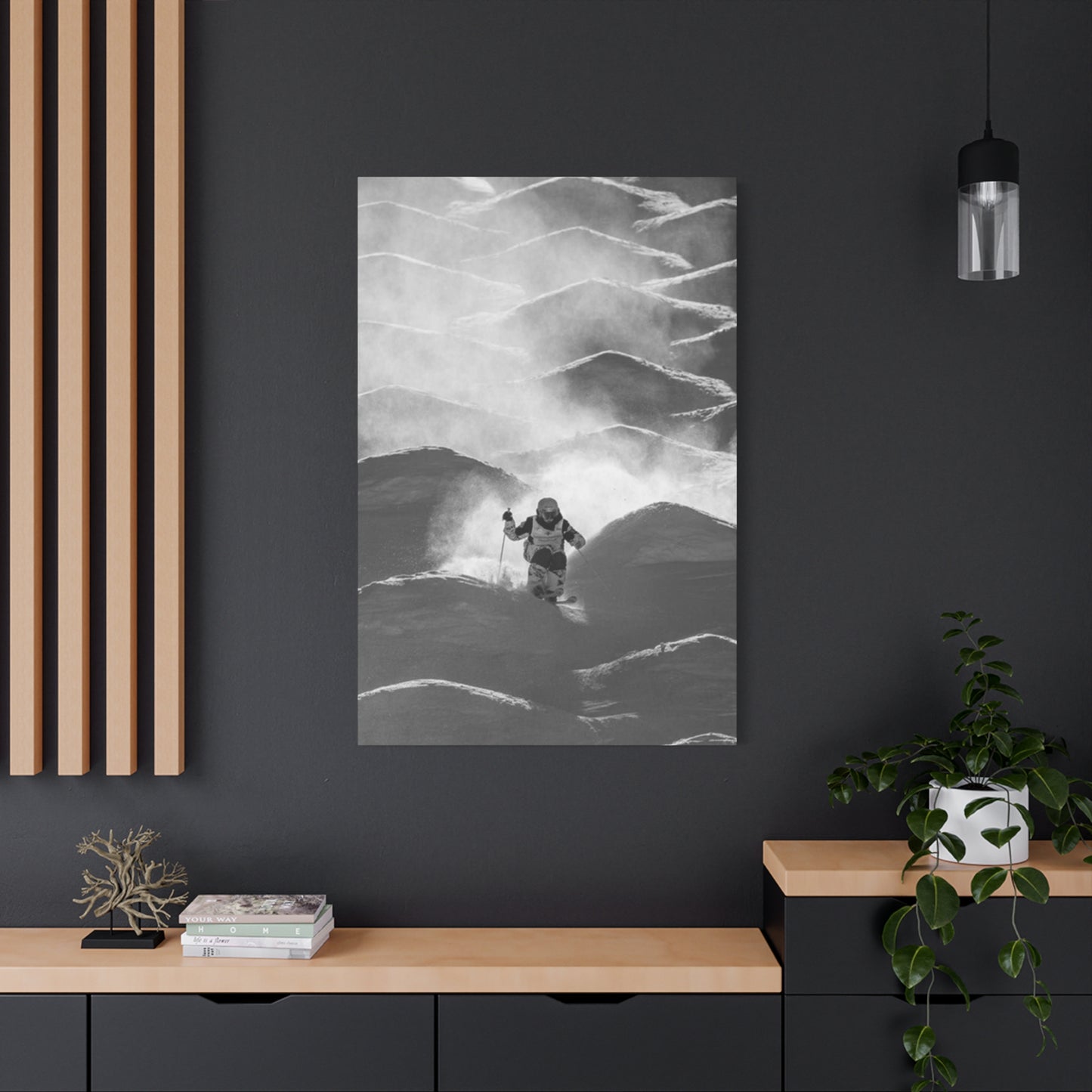Black & White Skiing Poster Wall Art & Canvas Prints
Black & White Skiing Poster Wall Art & Canvas Prints
Couldn't load pickup availability
Alpine Sophistication: Stunning Black & White Skiing Poster Wall Art for a Refined Living Space
The allure of mountain sports captured through monochrome imagery has become an increasingly popular choice for interior decoration enthusiasts worldwide. When homeowners seek to infuse their living quarters with dynamic energy and sophisticated aesthetics, black and white skiing poster wall art emerges as an exceptional solution that bridges athletic passion with refined visual appeal.
The timeless appeal of grayscale photographic prints stems from their ability to transcend temporary trends while maintaining perpetual relevance. Unlike colorful alternatives that might clash with evolving color schemes, monochromatic representations of alpine activities possess an inherent versatility that complements virtually any decorative approach. The stark contrast between shadowy depths and luminous highlights creates visual drama that commands attention without overwhelming surrounding elements.
Architectural photographers and sports documentarians have long recognized the power of removing chromatic information to emphasize form, movement, and emotional resonance. When applied to skiing imagery, this reductive approach highlights the elegant arcs carved through pristine snowfields, the tension in an athlete's physique during descent, and the majestic grandeur of mountainous terrain. The absence of color paradoxically intensifies the viewer's connection to the subject matter by eliminating distractions and focusing attention on compositional elements.
Contemporary residential spaces increasingly favor minimalist aesthetics characterized by clean lines, neutral palettes, and carefully curated accent pieces. Within this context, black and white skiing poster wall art functions as both complement and counterpoint—harmonizing with subdued surroundings while introducing kinetic energy through depicted motion. The genre's inherent sophistication aligns perfectly with modern sensibilities that prize understated elegance over ostentatious display.
Exploring the Diverse Stylistic Approaches Within Alpine Sport Visual Representations
The realm of skiing-themed wall decorations encompasses remarkable diversity in stylistic interpretation and compositional philosophy. Vintage-inspired prints often feature classic skiing postures from mid-century resort culture, evoking nostalgic associations with the golden age of alpine tourism. These retrospective pieces frequently incorporate grain structure and tonal characteristics reminiscent of silver gelatin prints, lending authenticity to their period aesthetic.
Contemporary action photography takes an entirely different approach, freezing split-second moments of athletic achievement with crystalline precision. These images typically showcase extreme angles, dramatic perspectives, and breathtaking environmental contexts that emphasize the sport's inherent excitement and danger. The photographer's technical mastery becomes evident in the rendering of individual snow particles suspended mid-air, the textural quality of weather-beaten equipment, and the palpable sense of velocity communicated through compositional choices.
Abstract interpretations represent another significant category within this artistic domain. These works prioritize graphic qualities over literal representation, reducing skiing scenes to essential geometric relationships and tonal patterns. Silhouetted figures against brilliant snow-covered slopes create striking positive-negative space dynamics, while close-up details of equipment or snow textures transform familiar subjects into nearly unrecognizable yet visually compelling compositions.
Minimalist renderings strip away extraneous information to focus on singular iconic elements—perhaps a lone skier navigating a vast mountainside or the graceful curve of a single track through unmarked powder. These restrained compositions embody the principle that effective visual communication often requires elimination rather than accumulation, allowing viewers to project their own interpretations and emotional responses onto deliberately ambiguous imagery.
Selecting the Perfect Dimensions and Proportions for Your Residential or Commercial Environment
Size considerations fundamentally impact both the visual effectiveness and spatial harmony of any wall-mounted artwork. Undersized pieces risk appearing insignificant and failing to establish meaningful presence within their surroundings, while excessively large selections can overwhelm spaces and create uncomfortable viewing experiences. The relationship between artwork dimensions and available wall space requires thoughtful calibration to achieve optimal results.
For expansive living rooms with substantial wall surfaces, oversized statement pieces measuring forty-eight inches or larger in their longest dimension command appropriate attention and serve as focal points around which additional decorative elements orbit. These grand-scale presentations particularly suit open-concept floor plans where visual continuity across connected spaces benefits from strong anchoring elements. The monumental presence of large-format skiing imagery can transform previously underutilized wall expanses into conversation-generating features.
Medium-sized presentations ranging from twenty-four to thirty-six inches offer versatility suitable for diverse contexts including bedrooms, home offices, and dining areas. These proportions achieve visibility without domination, allowing other furnishings and decorative objects to maintain their own presence while contributing to cohesive overall aesthetics. Multiple medium-format pieces arranged in thoughtful groupings create gallery-style presentations that introduce rhythmic variation and compositional complexity.
Compact formats below twenty inches serve specific purposes in smaller spaces, hallways, powder rooms, or as components within larger multi-piece installations. While individually modest, these diminutive works gain significance through strategic placement and thoughtful curation. Clustered arrangements of small-format prints can generate visual impact exceeding that of single larger pieces by introducing variety in subject matter, perspective, and tonal range while maintaining stylistic coherence.
Aspect ratio considerations prove equally important in achieving satisfying visual balance. Panoramic formats emphasizing horizontal extension naturally complement architectural features like mantels, console tables, and horizontal sight lines, while vertical orientations suit narrow wall sections and spaces where upward visual movement feels appropriate. Square formats offer geometric stability and work particularly well in symmetrical arrangements or as standalone statements in carefully edited spaces.
Framing Choices That Enhance Rather Than Compete With Alpine Sport Imagery
The presentation framework surrounding skiing imagery significantly influences its aesthetic impact and longevity. Frame selection represents more than mere protective function—it establishes boundaries, directs attention, and contributes substantially to overall visual character. When approaching this decision, consideration must extend beyond personal preference to encompass relationship with both artwork and surrounding environment.
Sleek metal frames fabricated from aluminum, steel, or brass provide contemporary edge suited to modern interiors. The narrow profile typical of metal framing maintains focus on imagery while introducing subtle metallic accents that catch and reflect ambient light. Black metal frames enhance the graphic quality of monochrome skiing prints through tonal harmony, while silver or gold finishes add luxurious notes without chromatic distraction. The clean geometry of metal framing aligns with minimalist principles and architectural sensibilities prevalent in contemporary design.
Traditional wood framing offers warmth and organic character that softens the crisp formality of black and white photography. Species selection dramatically affects overall impression—light woods like maple or ash contribute Scandinavian simplicity, while darker walnut or espresso finishes introduce gravitas and classical refinement. Wood grain patterns add textural complexity that complements rather than competes with photographic subjects. For rustic or lodge-inspired interiors, reclaimed wood or distressed finishes establish authentic connections to alpine architectural traditions.
Matting decisions prove equally consequential in final presentation quality. Generous mat borders provide breathing room that prevents imagery from feeling cramped while elevating perceived value through museum-quality presentation standards. White or cream mats maintain classical elegance and emphasize the purity of monochrome photography, while darker charcoal or black mats create more dramatic, gallery-inspired presentations. Double matting with subtle color or tonal variation adds dimensional depth and sophisticated polish.
Frameless mounting systems appeal to those favoring minimalist presentations where artwork appears to float independently against wall surfaces. Acrylic or plexiglass face-mounting techniques protect prints while introducing glossy contemporary character. Standoff mounts using metal hardware create shadow gaps that enhance dimensional presence without traditional frame structures. These approaches particularly suit modern spaces where architectural minimalism extends to decorative choices.
Strategic Placement Principles for Maximum Visual Impact Throughout Your Property
Positioning artwork involves more than identifying available wall space—it requires understanding sightlines, lighting conditions, surrounding elements, and intended emotional resonance. Thoughtful placement transforms decorative objects into integral environmental components that shape spatial experience and emotional atmosphere.
Living room installations benefit from positioning that makes skiing imagery visible upon entry, immediately establishing room character and conversational focus. Placement above substantial furniture pieces like sofas or consoles creates anchored relationships that feel deliberate rather than arbitrary. The artwork's center point should typically align with average eye level, approximately fifty-seven to sixty inches from floor level, though this guideline adjusts based on ceiling height and furniture proportions.
Bedroom applications often emphasize personal connection over public display, suggesting placement visible from bed position upon waking. This intimate relationship with alpine imagery can evoke inspirational associations that positively influence daily mindset. Above headboard placement creates balanced composition with bed as foundational element, while opposite-wall positioning allows contemplative viewing from reclined positions.
Home office and study environments benefit from skiing imagery's dynamic energy and achievement-oriented associations. Placement within natural sightlines during desk work provides periodic mental refreshment through brief visual engagement. The depicted athletic pursuit's demands for focus, perseverance, and strategic thinking create subtle psychological reinforcement for professional endeavors.
Hallways and transitional spaces represent underutilized opportunities for meaningful artwork display. Gallery-style arrangements transforming corridors into curated exhibitions generate visual interest in otherwise purely functional areas. The sequential viewing experience as one moves through space allows narrative development through multiple related images documenting various skiing moments or perspectives.
Dining areas gain sophisticated atmosphere through carefully selected alpine imagery that avoids overly energetic compositions potentially disrupting mealtime tranquility. More contemplative skiing scenes emphasizing environmental beauty over athletic intensity suit these social gathering spaces. Placement should consider viewing angles from seated positions around dining tables to ensure comfortable visual access for all occupants.
Lighting conditions dramatically affect artwork visibility and preservation. Direct sunlight causes fading and material degradation over time, necessitating placement avoiding intense solar exposure or implementation of UV-filtering glazing. Dedicated picture lighting through adjustable fixtures or track systems ensures proper illumination while creating dramatic nighttime presentations. Consideration of both natural and artificial light sources throughout daily cycles prevents surprises regarding artwork visibility under varying conditions.
Complementary Decorative Elements That Create Cohesive Alpine-Inspired Aesthetics
Black and white skiing poster wall art achieves greatest impact when supported by thoughtfully selected surrounding elements that reinforce rather than contradict its visual language and thematic content. Building cohesive decorative schemes requires attention to color relationships, material selections, and conceptual connections.
Neutral color palettes provide ideal backdrops for monochrome photography, allowing the artwork's tonal range to remain focal without competing chromatic elements. Walls painted in shades of white, cream, greige, or pale gray create clean canvases that emphasize graphic qualities of black and white imagery. Accent colors drawn from natural alpine environments—soft sage greens, warm caramel tones, or muted slate blues—introduce visual interest while maintaining thematic consistency.
Textile selections offer opportunities to reinforce the cozy warmth associated with mountain retreats. Throws and pillows in chunky knit fabrics, faux fur, or wool felt echo the textures of cold-weather gear without literal costume recreation. Geometric patterns inspired by Nordic design traditions complement the clean lines of monochrome photography while adding scaled pattern interest. Natural fiber rugs in wool or jute ground spaces with organic texture that balances the sleekness of framed prints.
Furniture choices should consider both stylistic harmony and functional appropriateness. Mid-century modern pieces with clean lines and organic forms complement monochrome skiing imagery's timeless aesthetic. Rustic elements crafted from reclaimed wood or weathered materials establish authentic connections to mountain lodge traditions without resorting to kitsch. Contemporary designs featuring metal and glass maintain sophisticated edge suited to urban interpretations of alpine style.
Decorative objects extending the mountain theme should exercise restraint to avoid theme-park excess. Vintage ski equipment displayed as sculptural elements—a pair of weathered wooden skis, antique poles, or classic bindings—adds authentic character and dimensional interest. Natural materials like stone, driftwood, or pine cones arranged in simple compositions reinforce environmental connections. Candles and lighting with warm tones create ambiance evoking the comfort of lodge firesides.
Plant selections introduce living elements that soften hard surfaces while maintaining naturalistic themes. Evergreen species like small conifers or cedar varieties directly reference alpine forests, while hardy succulents and air plants suit more contemporary interpretations. Arrangements in simple ceramic or concrete vessels maintain visual simplicity aligned with monochrome aesthetic principles.
Understanding Print Quality Factors That Determine Longevity and Visual Fidelity
The production methods and material specifications underlying skiing poster creation dramatically affect both immediate visual quality and long-term durability. Informed consumers recognize that apparent bargains often represent false economy when inferior materials degrade rapidly or fail to deliver satisfying presentation quality.
Giclée printing technology represents the current gold standard for fine art reproduction, utilizing archival pigment inks and acid-free substrates to produce gallery-quality results with exceptional tonal range and detail rendering. The term itself derives from French vocabulary meaning "to spray," referencing the precisely controlled inkjet process that deposits microscopic droplets in calculated patterns. Properly executed giclée prints exhibit smooth tonal transitions, accurate color neutrality in grayscale work, and resistance to fading that can exceed one hundred years under appropriate display conditions.
Paper selection proves equally critical in determining final print character and longevity. Cotton rag papers offer superior archival properties compared to wood-pulp alternatives, resisting yellowing and brittleness that afflict lesser materials. Surface texture ranging from smooth to pronounced affects image appearance and tactile quality—matte surfaces minimize reflections and lend subdued elegance, while subtle textures add dimensional interest that can enhance perceived depth. Weight measured in grams per square meter indicates substantiality, with heavier papers communicating quality and resisting handling damage.
Canvas substrates provide alternative presentation options particularly suited to casual environments or those seeking gallery-wrapped presentations without traditional framing. Museum-quality canvas features tight weaves and appropriate coating that accepts ink without excessive absorption or surface sheen issues. Stretching over wooden frames requires proper tension and corner treatment to prevent warping or corner distortion over time.
Metal prints represent contemporary alternatives where skiing imagery receives dye-sublimation transfer onto aluminum panels. The resulting presentations offer exceptional durability, vibrant tonal qualities, and modern aesthetic character. The metallic substrate introduces subtle luminosity that can enhance snow's brilliant quality and add dimensional depth to shadowy areas.
Print resolution measured in dots per inch determines image sharpness and detail rendering capability. Professional-quality reproduction requires minimum three hundred DPI at final printed size to ensure crisp detail and smooth tonal transitions. Lower resolution results in visible pixelation, muddy details, and overall impression of inferior quality that undermines artistic intent.
Ink quality directly impacts color fidelity, tonal range, and fade resistance. Pigment-based formulations offer superior longevity compared to dye-based alternatives, with careful encapsulation protecting colorants from environmental degradation. Neutral black and gray ink formulations specifically designed for monochrome work prevent color casts that can afflict prints produced using standard CMYK ink sets.
Sourcing Authentic Skiing Imagery From Reputable Artists and Photographers
The provenance and licensing status of skiing imagery affects both legal compliance and ethical considerations regarding artist compensation. Navigating the marketplace for alpine sports photography requires awareness of various acquisition channels and their respective characteristics.
Independent photographers specializing in mountain sports documentation offer direct access to unique imagery unavailable through mass-market channels. These practitioners typically maintain portfolio websites showcasing their work and offering limited edition prints that include artist signatures and certificates of authenticity. Direct purchase from creators ensures full licensing compliance while providing maximum financial support to working artists. Many photographers offer customization regarding size, substrate, and finishing specifications to meet specific project requirements.
Curated online galleries aggregate work from multiple artists within specialized niches, providing convenient browsing across diverse stylistic approaches and subject interpretations. Reputable platforms verify licensing rights and ensure proper artist compensation through their transaction structures. Quality-focused galleries typically provide detailed specifications regarding print methods, material selections, and provenance documentation that inform purchase decisions.
Print-on-demand services offer extensive catalogs spanning countless subjects and styles at accessible price points. While convenient and affordable, these platforms vary significantly in quality standards, artist compensation models, and licensing compliance. Careful evaluation of production specifications, sample viewing when possible, and review research helps identify reputable providers within this diverse marketplace segment.
Limited edition prints carry special significance for collectors valuing exclusivity and potential value appreciation. These numbered releases restrict total production quantities, with lower edition numbers and artist signatures enhancing desirability. Authentication documentation proving edition legitimacy and artwork provenance becomes essential for maintaining investment value.
Vintage and antique skiing posters represent distinct collecting category with historical significance beyond mere decorative function. Original period pieces from mid-century ski resorts or early winter sports promotion campaigns carry cultural value reflecting evolving attitudes toward mountain recreation. Authentication becomes paramount when acquiring vintage materials, as reproduction and forgery issues affect this market segment.
Licensing considerations require attention when reproducing skiing imagery beyond personal display purposes. Commercial applications, publication contexts, or any usage generating revenue typically require explicit permissions and appropriate fee payment. Even personal use prints should verify that source imagery carries proper usage rights to avoid copyright infringement issues.
Creating Gallery Wall Arrangements That Showcase Multiple Alpine Sport Perspectives
Multi-piece installations allow exploration of skiing themes through varied perspectives, moments, and compositional approaches while generating visual impact exceeding individual components. Successful gallery walls balance variety with cohesion, establishing rhythmic relationships that guide viewing experiences without creating chaotic impressions.
Symmetrical grid arrangements impose organizational structure that emphasizes orderliness and intentional curation. Uniform spacing between identically sized frames creates architectural quality suited to formal environments or spaces where visual restraint feels appropriate. This approach works particularly well with series documentation following consistent compositional formulas or technical specifications that benefit from standardized presentation.
Salon-style hangings embrace controlled asymmetry, mixing frame sizes and arrangements in visually balanced but non-geometric configurations. This more relaxed approach suits eclectic interiors and allows incorporation of varied artwork dimensions. Successful salon walls require careful planning—mock arrangements on floor or using paper templates ensure satisfying results before committing holes to walls. Visual weight distribution prevents lopsided impressions, with larger pieces anchoring arrangements while smaller works fill surrounding areas.
Linear sequences arranged horizontally or vertically create narrative progressions that unfold as viewers move along their length. These arrangements particularly suit hallway applications or wall expanses where extended horizontal or vertical dimensions invite sequential viewing. Thematic progression might document a skiing run from summit to base, contrast different skiing styles or eras, or explore varied environmental conditions.
Themed groupings organized around specific concepts generate conceptual coherence that enhances individual pieces through collective context. A gallery wall might explore vintage skiing through period poster reproductions, contrast skiing and snowboarding cultures, or examine alpine environments across different geographic regions. Conceptual organization transforms decorative arrangements into meaningful explorations of particular themes.
Frame variety introduces visual texture and personality but requires careful handling to avoid chaotic results. Mixing wood and metal frames, varying profiles from slim to substantial, or alternating black and natural wood finishes adds complexity while maintaining monochrome imagery as unifying element. Consistent matting choices or color palette restrictions help unify diverse framing selections.
Spacing standards significantly impact gallery wall success. Professional installers typically maintain two to three inches between adjacent frames in densely arranged walls, with increased spacing creating breathing room in more relaxed configurations. Consistent spacing appears more intentional than varied gaps suggesting haphazard placement.
Vertical and horizontal alignment creates invisible organizational grids that impose order even within asymmetric arrangements. Aligning top edges, bottom edges, or central axes of multiple pieces establishes visual connections that help viewers parse complex arrangements. These invisible structural relationships prevent arrangements from appearing arbitrary or chaotic.
Psychological Resonances and Emotional Associations Evoked by Mountain Sport Imagery
Beyond purely aesthetic considerations, skiing imagery carries rich symbolic and emotional content that affects spatial atmosphere and occupant mindset. Understanding these deeper dimensions allows intentional cultivation of desired environmental character and personal resonance.
Alpine environments evoke powerful associations with natural grandeur, pristine wilderness, and distance from mundane concerns of daily routine. Skiing imagery invokes these qualities, introducing symbolic connections to unspoiled landscapes and transcendent natural beauty. For urban dwellers particularly, these visual references provide psychological respite and mental transportation to environments dramatically different from their immediate surroundings.
Athletic achievement depicted in skiing photographs resonates with universal human aspirations toward mastery, challenge acceptance, and personal growth. The sport's technical demands and physical risks create metaphorical frameworks applicable beyond literal skiing contexts. Viewers may unconsciously draw parallels between depicted athletic endeavors and their own professional challenges, creative pursuits, or personal development journeys.
Freedom and exhilaration communicate through dynamic skiing imagery, particularly action shots capturing peak moments of descent. The sense of unencumbered movement through space, mastery over gravity and terrain, and pure kinesthetic joy translates across the visual barrier. These qualities inject spaces with energizing influences that can positively affect mood and outlook.
Seasonal associations connect skiing imagery to winter months, potentially evoking nostalgia for holiday periods, family traditions, or memorable vacation experiences. For those with personal skiing backgrounds, these visual references may trigger specific memory recall and emotional responses tied to formative experiences or ongoing passionate engagement with the sport.
Solitude versus community themes emerge depending on compositional choices. Lone figures traversing vast mountainsides emphasize contemplative isolation and individual challenge, while group compositions or resort scenes suggest social connection and shared experiences. These varying approaches suit different personality types and spatial intentions—private retreats versus communal gathering spaces.
Risk and adventure elements inherent in mountain sports attract those drawn to challenges and unconventional paths. The controlled danger of skiing appeals to adventurous temperaments while remaining accessible enough for broad participation. Imagery emphasizing these qualities may particularly resonate with entrepreneurs, creative professionals, or others whose life paths embrace calculated risk-taking.
Maintaining and Preserving Your Mountain Sport Wall Decorations for Generational Enjoyment
Proper stewardship ensures skiing artwork maintains its visual quality and physical integrity across decades of display. Understanding environmental threats and implementing appropriate protective measures prevents premature deterioration that diminishes both aesthetic appeal and potential monetary value.
Light exposure represents the primary degradation threat for all photographic materials. Ultraviolet radiation causes chemical changes in both paper substrates and ink or pigment materials, resulting in fading, color shifts, and paper yellowing. Minimizing direct sunlight exposure through strategic placement, window treatments, or UV-filtering glazing dramatically extends print lifespan. Even artificial lighting contributes cumulative exposure, suggesting occasional rotation of displayed works to distribute exposure across collections.
Humidity control prevents moisture-related damage including mold growth, paper cockle, and adhesive failure in mounted or matted prints. Maintaining relative humidity between forty and fifty percent creates stable conditions inhospitable to biological growth while preventing brittleness associated with excessive dryness. Dehumidifiers, humidifiers, or whole-house climate control systems maintain appropriate ranges in challenging environments.
Temperature stability prevents expansion-contraction cycles that stress materials and accelerate aging processes. Dramatic fluctuations prove particularly damaging, suggesting placement away from heating vents, radiators, or air conditioning outlets delivering direct airflow. Moderate consistent temperatures between sixty-five and seventy-five degrees Fahrenheit represent ideal preservation conditions.
Physical protection through appropriate glazing prevents surface damage from dust accumulation, accidental contact, or airborne contaminants. Standard glass offers basic protection but adds weight and breakage risk. Acrylic alternatives provide lighter weight and shatter resistance with optical clarity approaching glass. Museum-quality glazing combines UV filtration with anti-reflective coatings that improve viewing while maximizing protection.
Cleaning procedures require gentle approaches that avoid material damage. Dusting frames and glazing using soft microfiber cloths removes surface accumulation without scratching. Glass or acrylic surfaces tolerate gentle cleaning with appropriate solutions, though moisture should never contact exposed print areas. Professional conservation services address more significant issues like foxing, tears, or adhesive failures requiring expert intervention.
Documentation through photography, purchase records, and certificates of authenticity preserves provenance information crucial for insurance purposes and potential future sale. Digital records stored securely ensure information survival even if physical documents suffer loss or damage. Detailed documentation including artist names, edition numbers, purchase dates, and acquisition sources supports accurate valuation and authentication.
Budget-Conscious Approaches for Acquiring Quality Alpine Sport Wall Decorations
Financial constraints need not preclude meaningful engagement with skiing artwork when strategic approaches identify quality options at various price points. Understanding value factors and alternative acquisition methods allows development of compelling collections without excessive expenditure.
Emerging artists and photographers typically offer work at substantially lower prices than established names, providing opportunities to acquire quality imagery while supporting developing talents. University art programs, local photography clubs, and online portfolio platforms connect buyers with promising creators whose recognition and pricing likely increase over time. Early acquisition of work by artists who subsequently gain prominence represents both aesthetic and potentially financial reward.
Print multiples and open edition releases trade exclusivity for affordability, making professional photography accessible to broader audiences. While lacking the cachet and potential appreciation of limited editions, these reproductions deliver identical visual impact at fraction of cost. For those prioritizing decorative function over investment potential, open editions represent rational choices.
Smaller format prints dramatically reduce costs while maintaining quality standards in production and materials. A collection of multiple small works can achieve comparable impact to single large pieces while offering greater flexibility in arrangement and variety in subject matter. Strategic grouping and thoughtful placement maximize the visual contribution of modest individual pieces.
Seasonal sales and promotional periods offer opportunities for significant savings from both independent artists and commercial galleries. Email lists and social media following ensure awareness of special offers and limited-time pricing. Year-end sales, holiday promotions, and clearance events can deliver substantial discounts on quality work.
Alternative substrate choices affect pricing while potentially suiting particular aesthetic preferences or installation contexts. Canvas prints typically cost less than equivalent paper prints with premium framing. Metal prints, despite their contemporary appeal and durability, often price competitively with traditionally framed photographs. Unframed prints allow phased investment, with initial acquisition followed by framing as budget permits.
Do-it-yourself framing substantially reduces costs for those possessing necessary skills and tools. Quality frame molding, mats, and glazing materials available through craft suppliers enable custom framing at fraction of professional service costs. Online tutorials and community workshops provide guidance for those developing these capabilities. However, valuable prints warrant professional handling given irreversibility of framing errors.
Environmental Consciousness in Selecting Sustainably Produced Mountain Sport Artwork
Growing awareness of environmental impacts extends to decorative purchases, with conscientious consumers seeking products aligning with sustainability values. The artwork production chain offers numerous intervention points where ecological considerations influence practices and outcomes.
Paper sourcing from responsibly managed forests certified through programs like Forest Stewardship Council ensures fiber supplies derive from operations balancing harvest with regeneration and ecosystem protection. Recycled content papers divert waste streams while reducing virgin material demand, though quality evaluation ensures recycled substrates meet aesthetic and archival standards. Bamboo and hemp papers offer rapidly renewable alternatives to traditional wood pulp sources.
Ink formulations increasingly employ plant-based carriers and reduced volatile organic compound content, minimizing air quality impacts and worker exposures during production. Water-based systems eliminate petroleum-derived solvents while achieving quality results suitable for professional reproduction. Pigment encapsulation technologies enhance longevity without relying on heavy metals or persistent environmental contaminants.
Local production and artist support reduces transportation footprints while strengthening regional creative economies. Prioritizing photographers and printers operating within reasonable geographic proximity eliminates transcontinental shipping impacts while facilitating direct relationships with makers. Local sourcing often enables customization and special requests difficult in anonymous mass-market transactions.
Minimalist packaging approaches eliminate excessive material use in shipping and presentation. Recyclable or compostable protective materials replace foam and plastic bubble wrap. Consolidated shipments combining multiple items reduce per-unit transportation impacts. Some sellers offer packaging return programs for reuse with subsequent orders.
Longevity itself represents sustainability—quality prints properly cared for serve multiple generations, contrasting with disposable decor replaced frequently. The archival standards characterizing fine art photography ensure decades of service without quality degradation demanding premature replacement. Timeless aesthetic choices resist stylistic obsolescence that afflicts trend-driven alternatives.
Secondary market engagement through vintage print acquisition, estate sale participation, or consignment gallery browsing diverts existing materials from waste streams while accessing unique historical pieces. Pre-owned artwork requires no new production, representing zero-impact acquisition apart from transaction and transportation elements.
Seasonal Rotation Strategies for Maintaining Fresh Visual Interest Throughout the Calendar Year
While permanent installations provide stability and familiarity, periodic artwork rotation prevents visual fatigue while allowing broader engagement with diverse pieces. Seasonal rotation particularly suits those with extensive collections or evolving aesthetic preferences seeking variety without wholesale redecorating.
Skiing imagery naturally associates with winter months, suggesting heightened relevance during cold-weather periods when mountain sports achieve peak participation and cultural prominence. Summer rotation to alternative themes reflecting warm-weather activities or different geographic environments creates seasonal appropriateness and maintains visual novelty. This approach requires storage solutions protecting non-displayed works from environmental damage during their dormant periods.
Storage conditions rival display environments in importance for preservation purposes. Climate-controlled spaces with stable temperature and humidity prevent degradation during storage periods. Horizontal stacking with acid-free interleaving papers prevents surface contact and transfer. Archival boxes or portfolio cases exclude light and dust while allowing air circulation. Vertical storage risks bending or warping and should be avoided for works lacking rigid backing.
Rotation schedules might align with equinoxes and solstices, calendar quarters, or monthly intervals depending on collection size and personal preference for change. Regular schedules prevent indefinite procrastination while creating anticipated refresh points. Digital documentation tracking rotation dates, storage locations, and condition notes supports systematic collection management.
Thematic rotation beyond seasonal considerations might emphasize color palettes, geographic regions, compositional styles, or personal associations. A winter display emphasizing cool tones and alpine subjects might yield to warm earth tones and forest landscapes in autumn. Geographic rotation explores different mountain ranges or international skiing destinations across successive displays.
Rotation opportunities facilitate assessment and curation, allowing reevaluation of pieces that no longer resonate or deserve prominence. This ongoing dialogue with collections prevents stagnation while permitting aesthetic evolution without permanent commitment to every acquisition. Pieces consistently passed over during rotation might warrant deaccessioning through sale or donation.
Gifting Considerations for Skiing Enthusiasts and Mountain Culture Aficionados
Black and white skiing poster wall art represents thoughtful gift selections for recipients demonstrating affinity for mountain sports, alpine environments, or sophisticated monochrome aesthetics. Strategic selection considers personal preferences, existing collections, and display contexts to ensure meaningful reception.
Personal skiing background significantly influences imagery preferences. Active participants may prefer action-oriented compositions celebrating athletic achievement and technical prowess, while recreational skiers might favor scenic beauty and environmental grandeur. Vintage enthusiasts drawn to sport history appreciate period imagery documenting equipment evolution and resort culture development. Understanding recipient engagement depth guides appropriate stylistic selection.
Geographic connections add personal significance when imagery documents specific resorts, mountain ranges, or regions holding special meaning for recipients. A print featuring their favorite ski destination or location of memorable experiences carries emotional resonance beyond generic alpine scenery. Research into personal skiing history identifies these meaningful connections.
Size selection for gifts requires either knowledge of recipient display plans or conservative choices avoiding problematic dimensions. Medium formats offer versatility suitable for various contexts without overwhelming typical residential spaces. Alternatively, gift certificates or collaborative selection processes allow recipients direct input regarding sizing decisions.
Framing decisions involve trade-offs between presentation completeness and recipient preference accommodation. Ready-to-hang framed pieces provide immediate display capability and communicate higher gift value through comprehensive presentation. However, framing choices reflect personal aesthetic preferences that may not align with recipient tastes or existing decor. Unframed prints allow recipients custom framing matching their specific preferences and interior design schemes.
Presentation quality extends to packaging and ancillary materials. Quality wrapping, information cards explaining artist background or imagery provenance, and care instructions demonstrate thoughtfulness beyond mere object transfer. Personal notes connecting gift selection to recipient interests or shared experiences add sentimental dimensions transcending commercial transactions.
Occasion appropriateness varies across ceremonial contexts. Housewarming gifts benefit from universal appeal and immediate functional relevance. Milestone birthdays or retirement celebrations might emphasize commemorative significance or personal passion acknowledgment. Holiday giving aligns naturally with winter sports imagery's seasonal associations.
Combining Skiing Imagery with Other Mountain Sport Representations for Comprehensive Alpine Themes
While skiing provides rich visual material, comprehensive mountain culture representations benefit from incorporating related winter sports and alpine activities. Thoughtful combinations create layered thematic environments transcending single-sport focus.
Snowboarding imagery introduces generational and cultural variation while maintaining winter mountain contexts. The sport's distinct technical approaches, equipment aesthetics, and cultural associations broaden represented perspectives. Contrasting skiing and snowboarding compositions might explore stylistic evolution or highlight commonalities beneath surface differences.
Mountaineering and alpine climbing representations shift focus from recreational descent to arduous ascent and summit achievement. These images often emphasize environmental extremes, human perseverance, and intimate engagement with vertical terrain. The contemplative qualities and endurance themes complement skiing's more immediate thrills.
Nordic skiing and cross-country variants introduce alternative movement vocabularies and environmental contexts. Often documented in forested or meadow settings rather than dramatic alpine bowls, these representations offer compositional contrast while maintaining winter sports coherence. The sports' emphasis on sustained effort over brief descents provides thematic counterpoint.
Après-ski culture and lodge life imagery humanizes athletic focus through social dimensions and comfort contrasts. Vintage resort posters, architectural photography of mountain chalets, or documentary images of gathering spaces acknowledge that mountain experiences extend beyond athletic pursuit to encompass community, relaxation, and civilized comfort amid wilderness settings.
Wildlife photography featuring species inhabiting alpine environments—mountain goats, ptarmigans, marmots—grounds human activities within broader ecological contexts. These representations acknowledge mountains as functioning ecosystems rather than merely recreational playgrounds, appealing to environmentally conscious sensibilities.
Historic documentation tracing skiing evolution from practical transportation through sporting development adds temporal depth to thematic explorations. Archival images documenting equipment progression, technique evolution, and cultural integration create educational dimensions while maintaining visual interest.
Architectural Considerations for Different Residential Styles and Interior Design Movements
Skiing imagery's aesthetic flexibility allows successful incorporation across diverse architectural vocabularies and design movements, though specific stylistic choices optimize compatibility with particular approaches.
Scandinavian design principles emphasizing simplicity, functionality, and natural material celebration align naturally with black and white skiing photography. The movement's characteristic white walls, blonde wood, and restrained ornamentation provide ideal contexts for monochrome imagery. Simple wooden frames or frameless mounting maintain design philosophy consistency. Emphasis on light-filled spaces complements photography's tonal subtleties.
Industrial aesthetics featuring exposed structural elements, metal accents, and urban edge accommodate skiing imagery through contrasting contexts that create unexpected juxtapositions. Mountain sport representations introduce natural world references into deliberately artificial environments, generating creative tension. Black metal frames and oversized formats suit industrial proportion and material palette.
Mid-century modern style's organic forms, geometric patterns, and sophisticated color relationships harmonize with black and white photography's timeless qualities. Period-appropriate vintage skiing posters particularly suit authentic mid-century interiors, while contemporary monochrome photography complements reproduction and inspired spaces. Slim-profile frames in wood or brass align with era aesthetics.
Contemporary minimalism benefits from skiing imagery's graphic qualities and ability to function as singular focal elements within spare environments. Large-scale photographs achieve sufficient presence to anchor otherwise minimal spaces without violating restraint principles. Frameless mounting or ultra-minimal metal frames maintain philosophical consistency.
Rustic and lodge-style interiors find natural affinity with skiing subject matter given direct thematic alignment. However, achieving sophistication requires avoiding heavy-handed literalism or theme-park excess. Black and white photography provides refined interpretive approach elevating typical lodge decoration beyond predictable choices. Reclaimed wood framing establishes material connections while maintaining visual quality.
Transitional spaces blending traditional and contemporary elements accommodate skiing imagery through carefully balanced framing and placement decisions. Combining classical wooden frames with modern monochrome photography bridges stylistic periods while maintaining coherence. This approach particularly suits those appreciating both heritage and contemporary sensibilities.
Commercial Space Applications Beyond Residential Display Contexts
Black and white skiing poster wall art extends beyond domestic contexts to enliven commercial environments where mountain sport associations enhance branding, atmosphere, or customer experience.
Hospitality venues including hotels, restaurants, and bars employ skiing imagery to establish regional identity, seasonal appropriateness, or adventurous brand personality. Mountain resort properties naturally gravitate toward alpine sports representations, though urban establishments may deploy these images to suggest aspirational lifestyle associations or transport patrons imaginatively beyond immediate surroundings.
Retail environments specializing in outdoor equipment, athletic apparel, or lifestyle goods use skiing imagery as environmental branding that reinforces merchandise positioning and target demographic identification. Large-format photographs create immersive branded environments that elevate shopping beyond mere transactions toward lifestyle affirmation.
Final Thoughts
Stunning black and white skiing poster wall art is an exceptional way to infuse your living space with alpine elegance, bringing the thrill and serenity of the mountains right into your home. Skiing, with its dynamic motion and breathtaking vistas, is a sport that represents both adventure and tranquility, and when captured in monochrome, it conveys a sense of dramatic contrast, timeless beauty, and sophisticated energy. The minimalist approach of black and white enhances the intricate details of the skier's movement, the sharp contours of the mountain slopes, and the play between light and shadow, creating a powerful visual experience that speaks to both the heart and the imagination.
One of the most compelling aspects of black and white skiing art is its ability to capture the essence of winter sports in a way that transcends the vividness of color. The stark contrast between the snow-covered landscape and the deep shadows of the skier and surroundings evokes a sense of raw, untamed energy. Each movement on the slopes is accentuated, whether it’s the graceful curve of a skier carving through powder or the dramatic heights of a mountain peak framed against the sky. The absence of color brings a deeper focus to the texture and form of the landscape—every snowflake, every slope, and every edge is more pronounced, offering a fresh perspective on the familiar beauty of alpine scenery.
Black and white skiing posters are also incredibly versatile when it comes to interior design. The neutral tones allow them to seamlessly blend into various room styles, whether modern, rustic, or industrial. In minimalist spaces, these posters can become an impactful focal point, adding a sense of movement and energy that contrasts beautifully with the simplicity of the decor. In a more traditional or cozy living room, the monochrome art can bring a sense of refined elegance, evoking feelings of nostalgia and the timeless nature of winter sports. Its adaptability ensures that black and white skiing art remains relevant as your style evolves, continuing to add depth and sophistication to any room.
Beyond their aesthetic qualities, skiing posters also carry symbolic resonance, representing freedom, adventure, and the spirit of challenge. Skiing, as a sport, often evokes the thrill of conquering the slopes, the beauty of the snow-capped mountains, and the tranquility found in the isolation of the high altitudes. Displaying such art in your home can serve as a reminder of your love for the outdoors, the excitement of adventure, or even a personal connection to winter sports. It can also evoke a sense of wanderlust, inspiring you to explore new landscapes, conquer new challenges, or simply appreciate the beauty of nature in all its forms.
In terms of display, stunning black and white skiing poster wall art is versatile and adaptable. A single large print can become the centerpiece of a room, adding drama and sophistication with its bold lines and high-energy composition. Alternatively, a series of smaller prints can create a dynamic and cohesive narrative that takes the viewer on a journey through the mountains, emphasizing the movement and grace of the sport. Framing choices can further enhance the mood of the artwork—sleek, black frames will complement the minimalist aesthetic of the monochrome palette, while natural wood frames can soften the sharp contrast and add a touch of warmth, echoing the natural beauty of alpine landscapes.
Ultimately, stunning black and white skiing poster wall art is not just a decoration; it’s an invitation to embrace the spirit of adventure, the beauty of winter landscapes, and the elegance of the alpine world. Whether you’re a skier yourself or simply appreciate the stunning power of mountain scenery, this artwork will elevate your living space, infusing it with energy, grace, and an air of timeless sophistication. It serves as both a tribute to the sport and a powerful visual statement, offering a stunning reminder of the thrill of the slopes, the majesty of the mountains, and the elegance of winter’s quiet beauty.
Share
